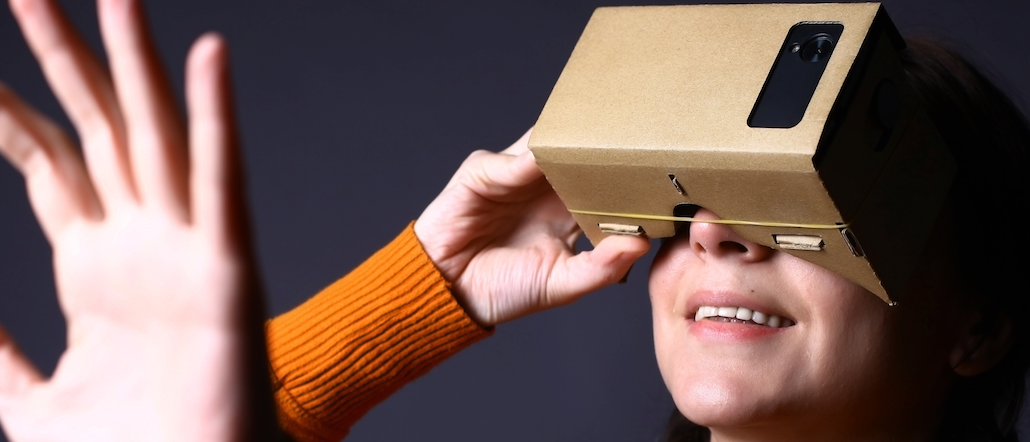In 2016, the most engaging experiences will be strapped to your head

Jordan Gray is manager of Organic’s Creative Labs.
Of the technologies we will see maturing for marketing use in 2016, virtual reality (VR) is the most exciting. The bravest brands have already dipped their toes in the water: The NBA was the first to VR stream a sports event, and The New York Times recently partnered with Google to get Cardboard viewers on the faces of their subscribers. Expect more.
While receiving a Cardboard VR viewer via direct mail may trigger flashbacks of the days when AOL trial discs were ubiquitous, the branded viewer seems less likely to wind up in recycling bins than your average flyer or conference swag. Phone holder headsets like Cardboard and Samsung Gear may not offer the same level of immersion as the commercial offerings Sony and Oculus are poised to release in early 2016, but they’re in people’s hands today, which make them a viable marketing tool.
With any new technology or tool, the first lazy forays will amount to little more than gimmicky executions, so no doubt we can expect to see plenty of senseless stunts in the coming year. For the OnePlus 2 Launch video, for example, dry content droned on long after the excitement around immersive video wore off. New frontiers guarantee there will be failures mixed in with the hits, but each experience in the wild gives us a better sense of virtual reality’s strengths and how to leverage them.
Currently, VR is being used where immersion is required. Short experiences are most practical: enough time to instill a sense of wonder or get a point across but not so long that a user feels isolated or gets bored. Highlight reels are more useful than real-time streaming in sports, for example. After fans enjoy a few miraculous minutes, they can pass the headset to nearby family or friends, gushing with excitement.
Immersion can be taken to the next level with on-site activations. Having control of the environment allows brands to use more sophisticated headsets to provide a greater sense of presence. More importantly, the headset can be just one prop in the stage of mixed reality. Example executions are already cropping up to excite the senses beyond sight: the scent of liquor wafting in the air while a crafting-of-bourbon story unfolds on the headset, riding a bicycle for a paper-boy game, and a simple fan blowing air over a flying simulator. North Face of Korea recently risked inducing cardiac arrest by sitting their customers down for a virtual sled ride — and then dragged the customers around a mall behind real dogs.
Brand perception and edutainment are easy targets for virtual reality, but headset technology is well poised to slide further down the marketing funnel. The Web brought window shopping home, but VR allows shoppers to step through that window. Today’s common online shopping tools, like 360-degree rotating photos and product-review videos, will feel flat compared to the offerings of VR. Clunky carts for saving items will be replaced with natural solutions that have already been play tested by inventory-juggling gamers. Previously cramped product-comparison charts will get a chance to stretch out in the nearly infinite screen space VR affords. With the added popularity of digital payments, there’s no need for shoppers to break from the headset to complete a purchase.
Going forward, it will be important for brands to consider schedules for VR releases. Committing to a refresh every month or quarter gives brands the chance to collect metrics and use them to shape VR content and formatting. Podcasters have already nailed the kind of audio that keeps subscribers engaged. 2016 is set to be a golden year for Realitycasters to explore how headset happenings will keep cyber citizens coming back for more.
Ad position: web_incontent_pos1
Virtual reality’s latest run around the block has already proven itself to excite the public. The proliferation of inexpensive phone holder headsets makes VR a viable medium today — there are already production studios that specialize in VR content. The rest is left in the hands of smart agencies and brave brands that are ready to try something new and stand out in the saturated media landscape.
More in Marketing

In the marketing world, anime is following in the footsteps of gaming
As marketers look to take advantage of anime’s entry into the zeitgeist, they might be wise to observe the parallels between the evolution of anime as a marketing channel and the ways brands have learned to better leverage gaming in recent years.

With the introduction of video ads and e-commerce, Roblox looks to attain platform status
Roblox is expanding into more areas than just ads in 2024. Much like platforms such as Amazon and Facebook have transcended their origins to evolve from their origins as online marketplaces and social media channels, Roblox is in the midst of a transformation into a platform for all elements of users’ virtual lives.

PepsiCo wants to remain a ‘driver of culture’ as it turns to influencers and activations amid rebrand
The soda-maker says it can translate cultural relevance into sales volume.
Ad position: web_bfu